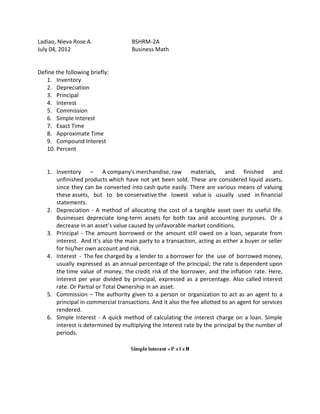Business math
•Als DOCX, PDF herunterladen•
4 gefällt mir•5,075 views
The document defines key business math terms: 1) Inventory includes a company's raw materials, finished goods, and goods in production that have not been sold. 2) Depreciation allocates the cost of tangible assets over their useful life for tax and accounting purposes. 3) Principal is the amount borrowed or still owed on a loan, separate from interest. 4) Interest is the fee charged by a lender for the use of borrowed money, usually expressed as an annual percentage of the principal.
Melden
Teilen
Melden
Teilen

Empfohlen
Pre calculus Grade 11 Learner's Module Senior High SchoolPre calculus Grade 11 Learner's Module Senior High School

Pre calculus Grade 11 Learner's Module Senior High SchoolMarinduque National High School, Marinduque State College
Weitere ähnliche Inhalte
Was ist angesagt?
Pre calculus Grade 11 Learner's Module Senior High SchoolPre calculus Grade 11 Learner's Module Senior High School

Pre calculus Grade 11 Learner's Module Senior High SchoolMarinduque National High School, Marinduque State College
Was ist angesagt? (20)
Pre calculus Grade 11 Learner's Module Senior High School

Pre calculus Grade 11 Learner's Module Senior High School
Ged-102-Mathematics-in-the-Modern-World-Module-pdf - Copy.docx

Ged-102-Mathematics-in-the-Modern-World-Module-pdf - Copy.docx
society and culture_ the filipino values and culture

society and culture_ the filipino values and culture
Contemporary World Chapter 8 Introduction Global City

Contemporary World Chapter 8 Introduction Global City
Strengths and Weaknesses of the Filipino Character

Strengths and Weaknesses of the Filipino Character
Education during the spanish regime and its colonial effects group 4

Education during the spanish regime and its colonial effects group 4
Andere mochten auch
Andere mochten auch (9)
MGA GAWAING PANGKALUSUGAN TUNGO SA MABIKAS NA PAGGAYAK

MGA GAWAING PANGKALUSUGAN TUNGO SA MABIKAS NA PAGGAYAK
Ähnlich wie Business math
Ähnlich wie Business math (20)
CHAPTER 5 FINANCIAL STATEMENTS ANALYSIS - II part i.docx

CHAPTER 5 FINANCIAL STATEMENTS ANALYSIS - II part i.docx
Managing Business Debts " A book to enlargen your horizon in managing busines...

Managing Business Debts " A book to enlargen your horizon in managing busines...
Question 1a. Net asset value = Market value of the portfolio (as.docx

Question 1a. Net asset value = Market value of the portfolio (as.docx
Basic Accounting Principles session 1 by Dino Leonandri

Basic Accounting Principles session 1 by Dino Leonandri
INV MANAGEMENT IT IS ABOUT PPT AND ITS DATA RELATED TO INVESTE,EMY

INV MANAGEMENT IT IS ABOUT PPT AND ITS DATA RELATED TO INVESTE,EMY
Sources and types of finance in business formation in Zimbabwe

Sources and types of finance in business formation in Zimbabwe
Business math
- 1. Ladiao, Nieva Rose A. BSHRM-2A July 04, 2012 Business Math Define the following briefly: 1. Inventory 2. Depreciation 3. Principal 4. Interest 5. Commission 6. Simple Interest 7. Exact Time 8. Approximate Time 9. Compound Interest 10. Percent 1. Inventory – A company's merchandise, raw materials, and finished and unfinished products which have not yet been sold. These are considered liquid assets, since they can be converted into cash quite easily. There are various means of valuing these assets, but to be conservative the lowest value is usually used in financial statements. 2. Depreciation - A method of allocating the cost of a tangible asset over its useful life. Businesses depreciate long-term assets for both tax and accounting purposes. Or a decrease in an asset’s value caused by unfavorable market conditions. 3. Principal - The amount borrowed or the amount still owed on a loan, separate from interest. And it’s also the main party to a transaction, acting as either a buyer or seller for his/her own account and risk. 4. Interest - The fee charged by a lender to a borrower for the use of borrowed money, usually expressed as an annual percentage of the principal; the rate is dependent upon the time value of money, the credit risk of the borrower, and the inflation rate. Here, interest per year divided by principal, expressed as a percentage. Also called interest rate. Or Partial or Total Ownership in an asset. 5. Commission – The authority given to a person or organization to act as an agent to a principal in commercial transactions. And it also the fee allotted to an agent for services rendered. 6. Simple Interest - A quick method of calculating the interest charge on a loan. Simple interest is determined by multiplying the interest rate by the principal by the number of periods.
- 2. Where: P- is the loan amount I- is the interest rate N -is the duration of the loan, using number of periods. 7. Exact Time - makes it possible to define allowed range of time in a relative-to-now plus- minus basis instead of exact time period. 8. Approximate Time - Almost exact or correct. 9. Compound Interest - Interest that accrues on the initial principal and the accumulated interest of a principal deposit, loan or debt. Compounding of interest allows a principal amount to grow at a faster rate than simple interest, which is calculated as a percentage of only the principal amount. 10. Percent - is as a ratio that shows a part of a whole. The technical name for the whole is base.
